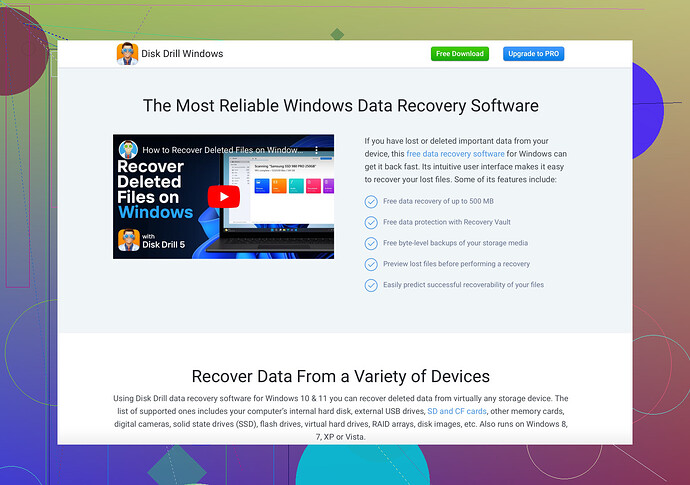I accidentally formatted my hard drive, and all my data is gone. Is there a way to recover it? I really need to retrieve my important files. Any help or recommendations?
Oh, the dreaded accidental format! It’s like giving your hard drive a lobotomy and realizing your digital brain is now mush. The good news is, recovering a formatted hard drive is definitely possible. Here’s what you can try:
-
Stop Using the Drive Immediately: Any new data writes could overwrite your old data, making recovery harder or impossible.
-
Recovery Software: You’ll want to use a data recovery tool. One of the best options out there is Disk Drill Data Recovery Software. It’s user-friendly, powerful, and has helped many people recover lost files from formatted drives.
-
Download and Install Disk Drill: Install it on a different drive or external storage to avoid overwriting the data you want to recover.
-
Scan the Formatted Drive: Launch Disk Drill and perform a deep scan on the formatted hard drive. This might take a while depending on the size of your drive.
-
Recover Your Files: After the scan, Disk Drill will list all recoverable files. You can preview and select what you want to recover. Save them to a different drive to prevent any overwriting on the formatted drive.
-
Backup, Backup, Backup: Once you’ve recovered your precious files, be sure to keep backups to avoid this nightmare in the future.
Trust me, Disk Drill is a lifesaver. It’s like having a digital detective uncovering your lost data. And no, it’s not black magic, just a really good recovery algorithm. Give it a shot and you might just breathe a huge sigh of relief when you see those files again.
Yikes, formatting a hard drive by accident can feel like a gut punch! But don’t lose hope just yet. Good call on stopping usage immediately - that’s crucial to avoid further data overwrite.
Let’s take a detour from the most common recovery software options because sometimes we need to think outside the box. You could consider a few alternative pathways:
-
Professional Data Recovery Services: If the drive contains exceptionally important data, professional services might be your best bet. Companies specializing in data recovery use advanced, proprietary tools that go beyond regular software. Beware, it can be pricey and not all services are created equal, so research thoroughly.
-
Check Built-In OS Tools: Before diving into third-party software, see if your operating system has built-in tools. On Windows, for instance, you could use File History or System Restore if these features were enabled before the formatting mishap. They might not recover everything but worth a shot.
-
TestDisk: This is an open-source data recovery utility that’s pretty powerful but requires some technical know-how. It’s less user-friendly than commercial options but could be a lifesaver if you’re tech-savvy.
-
Photorec: Another free tool, although it has a steeper learning curve, it’s excellent for recovering lost files from various devices.
-
Physical Faults: Check if there are any physical issues with your hard drive that might require professional intervention by data recovery experts. If the drive is making weird noises or not spinning up, don’t attempt further DIY recovery.
On the software side of things, it’s hard to beat Disk Drill for user-friendly, efficient recovery. It’s definitely worth the mention - their algorithm is top-notch at piecing together your lost data.
After you succeed in retrieving your files, maybe it’s time to think about a more robust backup strategy moving forward. Cloud services, external backups, and even network-attached storage can save you from future heartaches.
Remember, recovery is a race against time and overwritten data, so act fast but wisely. Hang in there!
Oh no, that accidental format, right? Let’s dive into some unconventional methods besides the ones @jeff and @yozora mentioned. Sometimes stepping outside the typical recommendations yields surprising results.
Bullet Points of Hope:
-
Linux Live CD: Boot from a Linux Live CD/USB. Using tools like GParted, you can inspect your drive without mounting it, minimizing data overwrite risk.
-
Low-Level Scan with Hiren’s Boot CD: This toolset includes various mini recovery tools, maybe not as shiny as Disk Drill but useful for nitty-gritty diagnostics.
Ups and Downs of Disk Drill:
-
Pros:
- Super user-friendly interface.
- Extensive file type support.
- Effective deep scanning algorithm.
-
Cons:
- Might be overkill if you’re dealing with basic recovery—pricey for infrequent usage.
Competitors to Consider:
- EaseUS Data Recovery Wizard: Similar usability, nice interface, yet some say it has slower scanning.
- Recuva: Free and efficient, but less powerful recovery capabilities for severely damaged drives.
Pro Tip: Physical Drive Check
If your drive makes clicking noises or isn’t detected: avoid software fixes—stop immediately and consult a pro. Physical drive issues need expert hands.
Lastly, once you’ve recovered (knock on wood), look into RAID setups or cloud redundancy. Let’s face it, mishaps happen. Better be safe!
Time is of the essence, spare no minute.
